Microstructural and Textural Investigation of an Mg-Zn-Al-Ca Alloy after Hot Plane Strain Compression
Abstract
1. Introduction
2. Materials and Methods
3. Results
3.1. Flow Curves
3.2. Microstructural Evolution
3.3. Texture Evolution
4. Conclusions
- Dynamic recrystallization is the dominant process in the formation of the microstructure during hot working of the Ca-containing magnesium alloy ZAX210.
- Depending on the strain rate, different mechanisms of DRX occur. At high strain rates (10 s−1), the formation of secondary twins and the nucleation of new grains within the twins is predominant. At low strain rates (0.1 s−1), continuous DRX occurs with the formation of characteristic necklace structures.
- TDRX leads to higher amount of recrystallized grains at high strain rates.
- The recrystallized areas show a weakened texture compared to the initial state. The texture shows basal pole splitting where the maxima are tilted away from the core intensity.
Author Contributions
Funding

Institutional Review Board Statement
Informed Consent Statement
Data Availability Statement
Acknowledgments
Conflicts of Interest
References
- Kamm, C. Magnesium-Taschenbuch, 1st ed.; Aluminium-Verlag: Düsseldorf, Germany, 2000. [Google Scholar]
- Vogel, M.; Kraft, O.; Arzt, E. Effect of calcium additions on the creep behavior of magnesium die-cast alloy ZA85. Metall. Mat. Trans. A 2005, 36, 1713–1719. [Google Scholar] [CrossRef]
- Krajňák, T.; Minárik, P.; Stráský, J.; Máthis, K.; Janeček, M. Mechanical properties of ultrafine-grained AX41 magnesium alloy at room and elevated temperatures. Mater. Sci. Eng. A 2018, 731, 438–445. [Google Scholar] [CrossRef]
- Zubair, M.; Sandlöbes, S.; Wollenweber, M.A.; Kusche, C.F.; Hildebrandt, W.; Broeckmann, C.; Korte-Kerzel, S. On the role of Laves phases on the mechanical properties of Mg-Al-Ca alloys. Mater. Sci. Eng. A 2019, 756, 272–283. [Google Scholar] [CrossRef]
- Stanford, N. The effect of calcium on the texture, microstructure and mechanical properties of extruded Mg–Mn–Ca alloys. Mater. Sci. Eng. A 2010, 528, 314–322. [Google Scholar] [CrossRef]
- Wang, C.; Ma, A.; Sun, J.; Liu, H.; Huang, H.; Yang, Z.; Jiang, J. Effect of ECAP process on as-cast and as-homogenized Mg-Al-Ca-Mn alloys with different Mg2Ca morphologies. J. Alloys Compd. 2019, 793, 259–270. [Google Scholar] [CrossRef]
- Ding, H.-L.; Zhang, P.; Cheng, G.-P.; Kamado, S. Effect of calcium addition on microstructure and texture modification of Mg rolled sheets. Trans. Nonferrous Met. Soc. China 2015, 25, 2875–2883. [Google Scholar] [CrossRef]
- Kim, K.-H.; Suh, B.-C.; Bae, J.H.; Shim, M.-S.; Kim, S.; Kim, N.J. Microstructure and texture evolution of Mg alloys during twin-roll casting and subsequent hot rolling. Scr. Mater. 2010, 63, 716–720. [Google Scholar] [CrossRef]
- Bae, G.T.; Bae, J.H.; Kang, D.; Lee, H.; Kim, N. Effect of Ca addition on microstructure of twin-roll cast AZ31 Mg alloy. Met. Mater. Int. 2009, 15, 1–5. [Google Scholar] [CrossRef]
- Chino, Y.; Sassa, K.; Huang, X.S.; Suzuki, K.; Mabuchi, M. Effects of zinc concentration on the stretch formability at room temperature of the rolled Mg-Zn-Ca alloys, Nippon Kinzoku Gakkaishi. J. Jpn. Inst. Met. 2011, 75, 35–41. [Google Scholar] [CrossRef]
- Chino, Y.; Ueda, T.; Otomatsu, Y.; Sassa, K.; Huang, X.S.; Suzuki, K.; Mabuchi, M. Effects of Ca on tensile properties and stretch formability at room temperature in Mg-Zn and Mg-Al alloys. Mater. Trans. 2011, 52, 1477–1482. [Google Scholar] [CrossRef]
- Mendis, C.L.; Bae, J.H.; Kim, N.J.; Hono, K. Microstructures and tensile properties of a twin roll cast and heat-treated Mg–2.4Zn–0.1Ag–0.1Ca–0.1Zr alloy. Scr. Mater. 2011, 64, 335–338. [Google Scholar] [CrossRef]
- Hänzi, A.C.; Sologubenko, A.S.; Gunde, P.; Schinhammer, M.; Uggowitzer, P.J. Design considerations for achieving simultaneously high-strength and highly ductile magnesium alloys. Philos. Mag. Lett. 2012, 92, 417–427. [Google Scholar] [CrossRef]
- Chai, Y.; Jiang, B.; Song, J.; Wang, Q.; Gao, H.; Liu, B.; Huang, G.; Zhang, D.; Pan, F. Improvement of mechanical properties and reduction of yield asymmetry of extruded Mg-Sn-Zn alloy through Ca addition. J. Alloys Compd. 2019, 782, 1076–1086. [Google Scholar] [CrossRef]
- Hoppe, R.; Kurz, G.; Letzig, D. Substitution of Rare Earths in Magnesium Alloys. Mater. Sci. Forum 2016, 854, 51–56. [Google Scholar] [CrossRef]
- Kurz, G.; Petersen, T.; Gonzales, I.P.; Hoppe, R.; Bohlen, J.; Letzig, D. Substitution of Rare Earth Elements in Magnesium Alloys for the Sheet Production Via Twin Roll Casting. In Magnesium Technology 2016; Singh, A., Solanki, K., Manuel, M.V., Neelameggham, N.R., Eds.; Springer International Publishing: Cham, Switzerland, 2016; pp. 377–382. [Google Scholar]
- Kittner, K.; Ullmann, M.; Henseler, T.; Prahl, U.; Kawalla, R. Dynamic recrystallization behaviour of Twin Roll Cast ZAX210 strips during hot deformation. In METAL 2019 Conference Proeedings; TANGER Ltd.: Greensboro, NV, USA, 2019; pp. 1528–1534. [Google Scholar]
- Kittner, K.; Ullmann, M.; Henseler, T.; Kawalla, R.; Prahl, U. Microstructure and Hot Deformation Behavior of Twin Roll Cast Mg-2Zn-1Al-0.3Ca Alloy. Materials 2019, 12, 1020. [Google Scholar] [CrossRef]
- Ullmann, M.; Kittner, K.; Henseler, T.; Stöcker, A.; Prahl, U.; Kawalla, R. Development of new alloy systems and innovative processing technologies for the production of magnesium flat products with excellent property profile. Procedia Manuf. 2019, 27, 203–208. [Google Scholar] [CrossRef]
- Neh, K.; Ullmann, M.; Kawalla, R. Substitution of rare earth elements in hot rolled magnesium alloys with improved mechanical properties. Mater. Sci. Forum 2016, 854, 57–64. [Google Scholar] [CrossRef]
- Rudi, R.S.; Kamado, S.; Ikeya, N.; Araki, T.; Kojima, Y. High Temperature Strength of Semi-Solid Formed Mg-Zn-Al-Ca Alloys. MSF 2000, 350–351, 79–86. [Google Scholar] [CrossRef]
- Anyanwu, I.A.; Kamado, S.; Honda, T.; Kojima, Y.; Takeda, S.; Ishida, T. Heat Resistance of Mg-Zn-Al-Ca Alloy Castings. MSF 2000, 350–351, 73–78. [Google Scholar] [CrossRef]
- Zhang, Z.; Tremblay, R.; Dubé, D. Microstructure and mechanical properties of ZA104 (0.3–0.6Ca) die-casting magnesium alloys. Mater. Sci. Eng. A 2004, 385, 286–291. [Google Scholar] [CrossRef]
- Moitra, A.; Kim, S.-G.; Horstemeyer, M.F. Solute effect on the <a+c> dislocation nucleation mechanism in magnesium. Acta Mater. 2014, 75, 106–112. [Google Scholar] [CrossRef]
- Barnett, M.R. Twinning and the ductility of magnesium alloys Part I: “Tension” twins. Mater. Sci. Eng. A 2007, 464, 1–7. [Google Scholar] [CrossRef]
- Park, S.H.; Hong, S.-G.; Lee, C.S. Activation mode dependent {10−12} twinning characteristics in a polycrystalline magnesium alloy. Scr. Mater. 2010, 62, 202–205. [Google Scholar] [CrossRef]
- Yu, Z.; Choo, H. Influence of twinning on the grain refinement during high-temperature deformation in a magnesium alloy. Scr. Mater. 2011, 64, 434–437. [Google Scholar] [CrossRef]
- Kim, D.-W.; Suh, B.-C.; Shim, M.-S.; Bae, J.H.; Kim, D.H.; Kim, N.J. Texture Evolution in Mg-Zn-Ca Alloy Sheets. Metall. Mat. Trans. A 2013, 44, 2950–2961. [Google Scholar] [CrossRef]
- Lee, J.Y.; Yun, Y.S.; Suh, B.C.; Kim, N.J.; Kim, W.T.; Kim, D.H. Comparison of static recrystallization behavior in hot rolled Mg-3Al-1Zn and Mg-3Zn-0.5Ca sheets. J. Alloys Compd. 2014, 589, 240–246. [Google Scholar] [CrossRef]
- Knezevic, M.; Levinson, A.; Harris, R.; Mishra, R.K.; Doherty, R.D.; Kalidindi, S.R. Deformation twinning in AZ31: Influence on strain hardening and texture evolution. Acta Mater. 2010, 58, 6230–6242. [Google Scholar] [CrossRef]
- Liu, X.; Jonas, J.J.; Li, L.X.; Zhu, B.W. Flow softening, twinning and dynamic recrystallization in AZ31 magnesium. Mater. Sci. Eng. A 2013, 583, 242–253. [Google Scholar] [CrossRef]
- Shang, S.L.; Wang, W.Y.; Zhou, B.C.; Wang, Y.; Darling, K.A.; Kecskes, L.J.; Mathaudhu, S.N.; Liu, Z.K. Generalized stacking fault energy, ideal strength and twinnability of dilute Mg-based alloys: A first-principles study of shear deformation. Acta Mater. 2014, 67, 168–180. [Google Scholar] [CrossRef]
- Kumar, M.A.; Beyerlein, I.J.; Lebensohn, R.A.; Tomé, C.N. Role of alloying elements on twin growth and twin transmission in magnesium alloys. Mater. Sci. Eng. A 2017, 706, 295–303. [Google Scholar] [CrossRef]
- Chapuis, A.; Liu, Q. Investigating the temperature dependency of plastic deformation in a Mg-3Al-1Zn alloy. Mater. Sci. Eng. A 2018, 725, 108–118. [Google Scholar] [CrossRef]
- Abouhilou, F.; Hanna, A.; Azzeddine, H.; Bradai, D. Microstructure and texture evolution of AZ31 Mg alloy after uniaxial compression and annealing. J. Magnes. Alloy. 2019, 7, 124–133. [Google Scholar] [CrossRef]
- Guan, D.; Rainforth, W.M.; Ma, L.; Wynne, B.; Gao, J. Twin recrystallization mechanisms and exceptional contribution to texture evolution during annealing in a magnesium alloy. Acta Mater. 2017, 126, 132–144. [Google Scholar] [CrossRef]
- Martin, É.; Mishra, R.K.; Jonas, J.J. Deformation Structures and Recrystallization in Magnesium Alloys. In Magnesium Alloys-Design, Processing and Properties; Czerwinski, F., Ed.; InTech: London, UK, 2011. [Google Scholar]
- Li, X.; Yang, P.; Wang, L.-N.; Meng, L.; Cui, F. Orientational analysis of static recrystallization at compression twins in a magnesium alloy AZ31. Mater. Sci. Eng. A 2009, 517, 160–169. [Google Scholar] [CrossRef]
- Al-Samman, T.; Molodov, K.D.; Molodov, D.A.; Gottstein, G.; Suwas, S. Softening and dynamic recrystallization in magnesium single crystals during c-axis compression. Acta Mater. 2012, 60, 537–545. [Google Scholar] [CrossRef]
- Xu, S.W.; Kamado, S.; Matsumoto, N.; Honma, T.; Kojima, Y. Recrystallization mechanism of as-cast AZ91 magnesium alloy during hot compressive deformation. Mater. Sci. Eng. A 2009, 527, 52–60. [Google Scholar] [CrossRef]
- Wu, Y.-Z.; Yan, H.-G.; Chen, J.-H.; Zhu, S.-Q.; Su, B.; Zeng, P.-L. Hot deformation behavior and microstructure evolution of ZK21 magnesium alloy. Mater. Sci. Eng. A 2010, 527, 3670–3675. [Google Scholar] [CrossRef]
- Yan, H.-G.; Wu, Y.-Z.; Chen, J.-H.; Zhu, S.-Q.; Liu, Z.-W.; Tian, J. Microstructure evolution of ZK40 magnesium alloy during high strain rate compression deformation at elevated temperatures. Mater. Sci. Technol. 2011, 27, 1416–1421. [Google Scholar] [CrossRef]
- Sanjari, M.; Farzadfar, S.A.; Jung, I.H.; Essadiqi, E.; Yue, S. Influence of strain rate on hot deformation behaviour and texture evolution of AZ31B. Mater. Sci. Technol. 2012, 28, 437–447. [Google Scholar] [CrossRef]
- Wu, Y.-Z.; Yan, H.-G.; Zhu, S.-Q.; Chen, J.-H.; Liu, A.-M.; Liu, X.-L. Flow behavior and microstructure of ZK60 magnesium alloy compressed at high strain rate. Trans. Nonferrous Met. Soc. China 2014, 24, 930–939. [Google Scholar] [CrossRef]
- SEP 1680: Aufstellung von Zeit-Temperatur-Umwandlungsschaubildern für Eisenlegierungen—Matplus Shop. Available online: https://matplus.shop/produkt/sep-1680-12-90-aufstellung-von-zeit-temperatur-umwandlungsschaubildern-fuer-eisenlegierungen (accessed on 28 August 2022).
- Müller, A.; Heger, D. Schnelle und unkomplizierte Präparation für Magnesium und seine Legierungen. In Proceedings of the Metallographie-Tagung (DGM), Bochum, Germany, 29 September–1 October 2004. [Google Scholar]
- Bachmann, F.; Hielscher, R.; Schaeben, H. Texture Analysis with MTEX–Free and Open Source Software Toolbox. SSP 2010, 160, 63–68. [Google Scholar] [CrossRef]
- Hansen, N. (Ed.) Annealing processes-recovery, recrystallization and grain growth. In Proceedings of the 7th Risø International Symposium on Metallurgy and Materials Science, Risø National Laboratory, Roskilde, Denmark, 8–12 September 1986. [Google Scholar]
- Beetles, C.; Barnett, M.R. (Eds.) Advances in Wrought Magnesium Alloys: Fundamentals of Processing, Properties and Applications; Elsevier: Amsterdam, The Netherlands, 2012. [Google Scholar]
- Al-Samman, T.; Gottstein, G. Room temperature formability of a magnesium AZ31 alloy: Examining the role of texture on the deformation mechanisms. Mater. Sci. Eng. A 2008, 488, 406–414. [Google Scholar] [CrossRef]
- Ishikawa, K.; Watanabe, H.; Mukai, T. High strain rate deformation behavior of an AZ91 magnesium alloy at elevated temperatures. Mater. Lett. 2005, 59, 1511–1515. [Google Scholar] [CrossRef]
- Wan, Y.; Tang, B.; Gao, Y.; Tang, L.; Sha, G.; Zhang, B.; Liang, N.; Liu, C.; Jiang, S.; Chen, Z.; et al. Bulk nanocrystalline high-strength magnesium alloys prepared via rotary swaging. Acta Mater. 2020, 200, 274–286. [Google Scholar] [CrossRef]
- Yang, Y.; Chen, X.; Nie, J.; Wei, K.; Mao, Q.; Lu, F.; Zhao, Y. Achieving ultra-strong Magnesium–lithium alloys by low-strain rotary swaging. Mater. Res. Lett. 2021, 9, 255–262. [Google Scholar] [CrossRef]
- Guerza-Soualah, F.; Azzeddine, H.; Baudin, T.; Helbert, A.-L.; Brisset, F.; Bradai, D. Microstructural and textural investigation of an Mg–Dy alloy after hot plane strain compression. J. Magnes. Alloy. 2020, 8, 1198–1207. [Google Scholar] [CrossRef]
- Wang, J.; Beyerlein, I.J.; Tomé, C.N. An atomic and probabilistic perspective on twin nucleation in Mg. Scr. Mater. 2010, 63, 741–746. [Google Scholar] [CrossRef]
- Brandon, D.G. The structure of high-angle grain boundaries. Acta Metall. 1966, 14, 1479–1484. [Google Scholar] [CrossRef]
- Barnett, M.R.; Keshavarz, Z.; Beer, A.G.; Ma, X. Non-Schmid behaviour during secondary twinning in a polycrystalline magnesium alloy. Acta Mater. 2008, 56, 5–15. [Google Scholar] [CrossRef]
- Ando, D.; Koike, J.; Sutou, Y. Relationship between deformation twinning and surface step formation in AZ31 magnesium alloys. Acta Mater. 2010, 58, 4316–4324. [Google Scholar] [CrossRef]
- Barnett, M.R.; Stanford, N.; Cizek, P.; Beer, A.; Xuebin, Z.; Keshavarz, Z. Deformation mechanisms in Mg alloys and the challenge of extending room-temperature plasticity. JOM 2009, 61, 19–24. [Google Scholar] [CrossRef]
- Ravichandran, N.; Prasad, Y.V.R.K. Dynamic recrystallization during hot deformation of aluminum: A study using processing maps. Metall. Trans. A 1991, 22, 2339–2348. [Google Scholar] [CrossRef]
- Humphreys, F.J.; Hatherly, M. Recrystallization and Related Annealing Phenomena, 2nd ed.; Elsevier: Amsterdam, The Netherlands; Heidelberg, Germany, 2004. [Google Scholar]
- Berman, T.D.; Pollock, T.M.; Jones, J.W. Texture, Second-Phase Particles, and the Anisotropy of Deformation Behavior in TTMP AZ61. Metall. Mat. Trans. A 2015, 46, 2986–2998. [Google Scholar] [CrossRef]
- Bhattacharjee, T.; Suh, B.-C.; Sasaki, T.T.; Ohkubo, T.; Kim, N.J.; Hono, K. High strength and formable Mg–6.2Zn–0.5Zr–0.2Ca alloy sheet processed by twin roll casting. Mater. Sci. Eng. A 2014, 609, 154–160. [Google Scholar] [CrossRef]
- Basu, I.; Al-Samman, T. Triggering rare earth texture modification in magnesium alloys by addition of zinc and zirconium. Acta Mater. 2014, 67, 116–133. [Google Scholar] [CrossRef]
- Griffiths, D. Explaining texture weakening and improved formability in magnesium rare earth alloys. Mater. Sci. Technol. 2015, 31, 10–24. [Google Scholar] [CrossRef]
- Al-Samman, T.; Li, X. Sheet texture modification in magnesium-based alloys by selective rare earth alloying. Mater. Sci. Eng. A 2011, 528, 3809–3822. [Google Scholar] [CrossRef]
- Hantzsche, K.; Bohlen, J.; Wendt, J.; Kainer, K.U.; Yi, S.B.; Letzig, D. Effect of rare earth additions on microstructure and texture development of magnesium alloy sheets. Scr. Mater. 2010, 63, 725–730. [Google Scholar] [CrossRef]
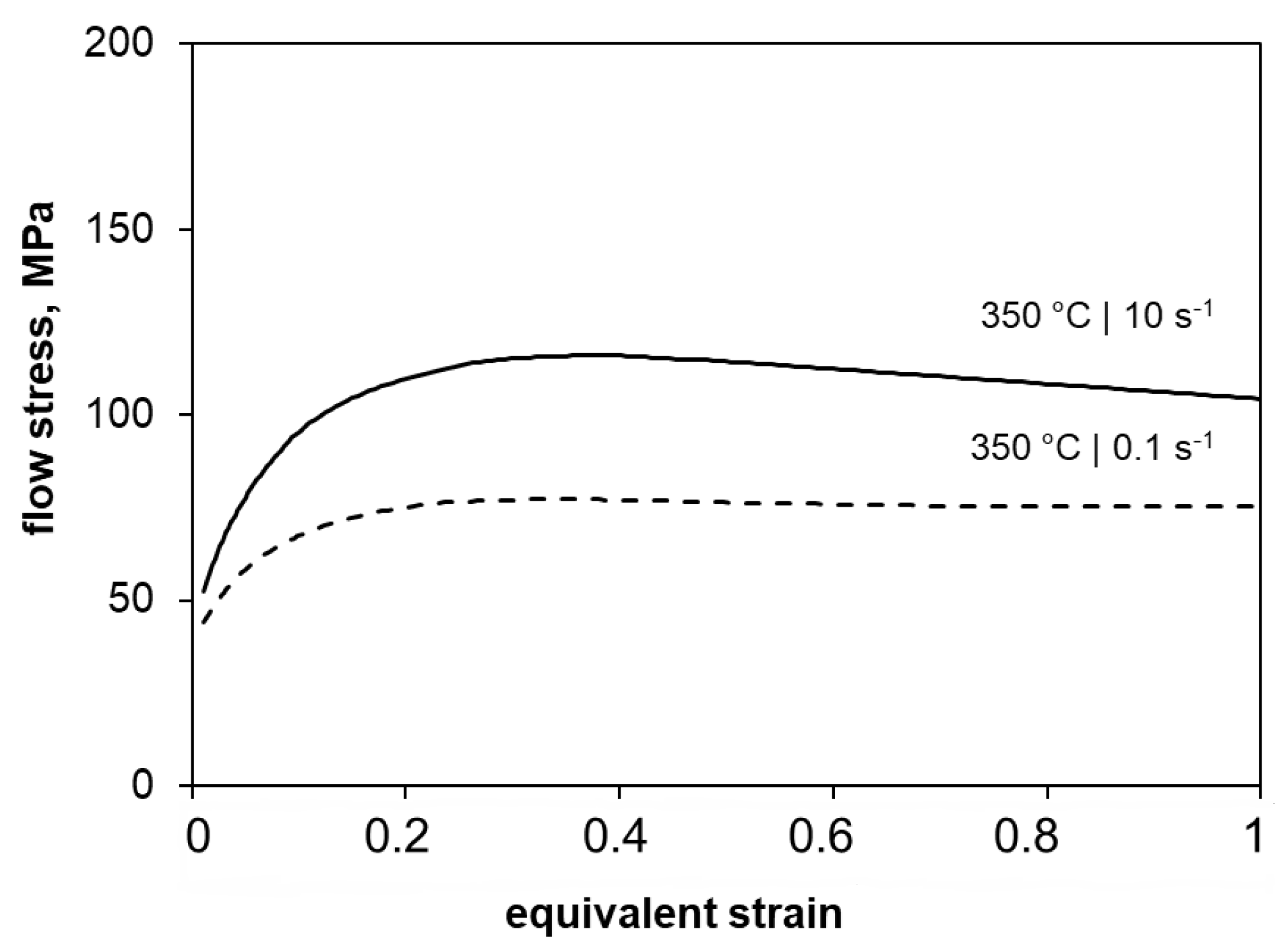
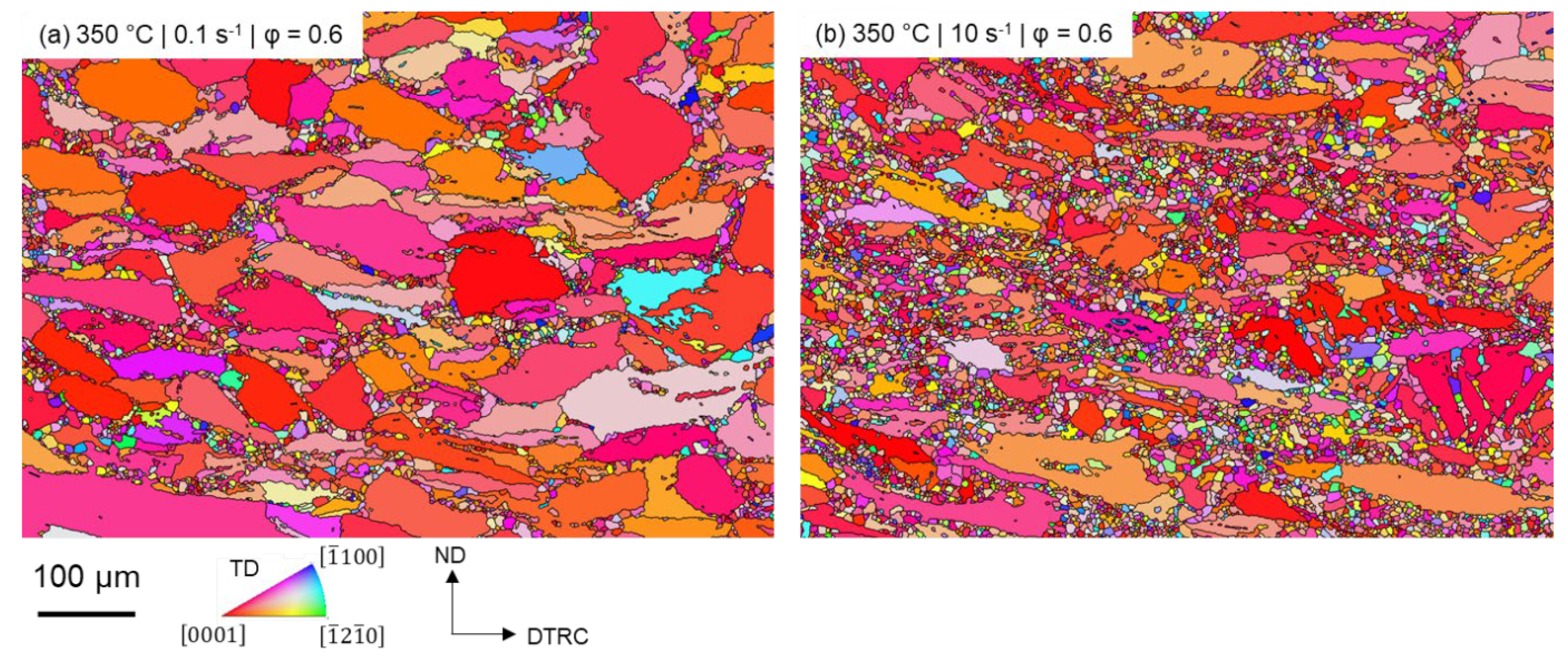
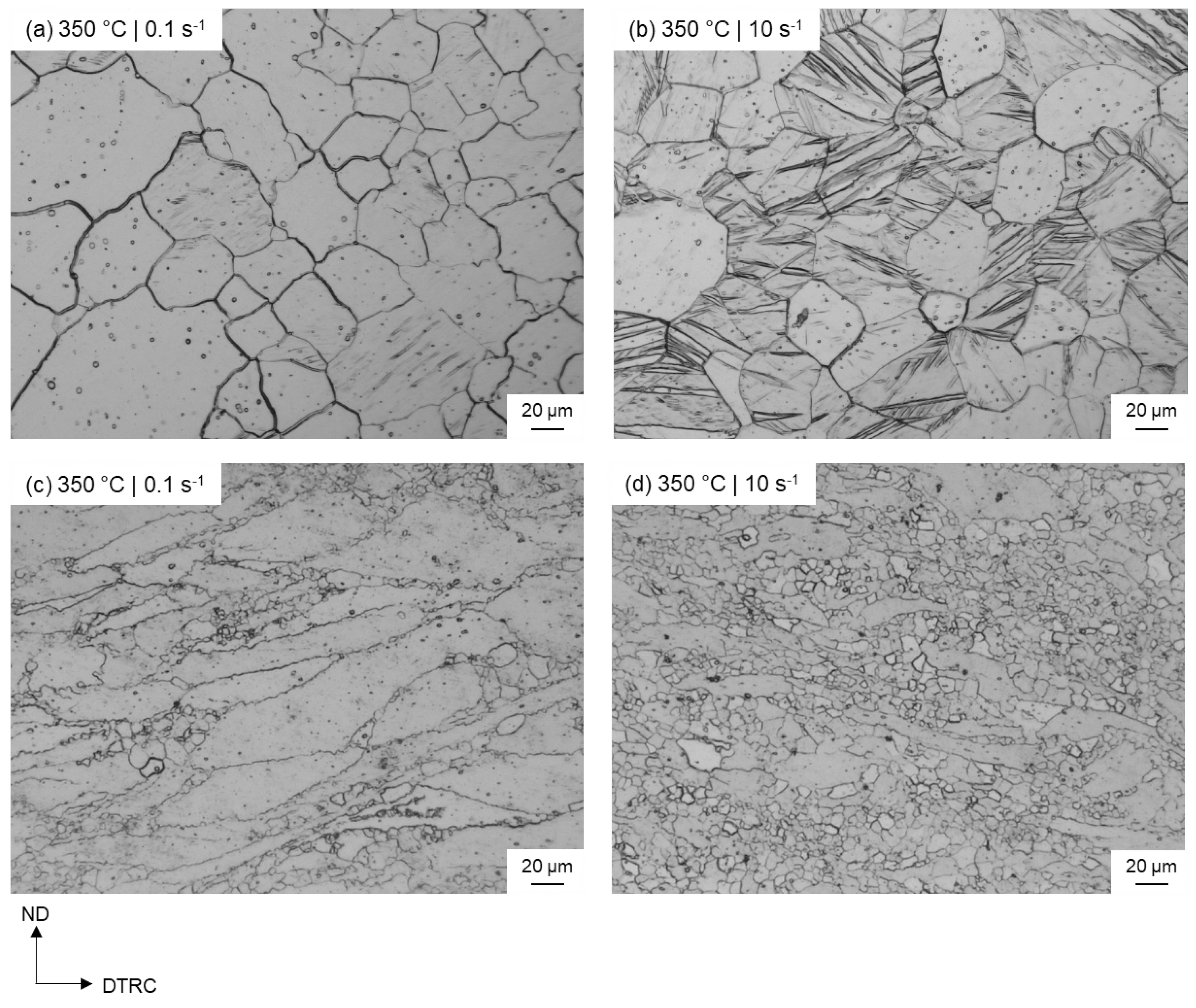
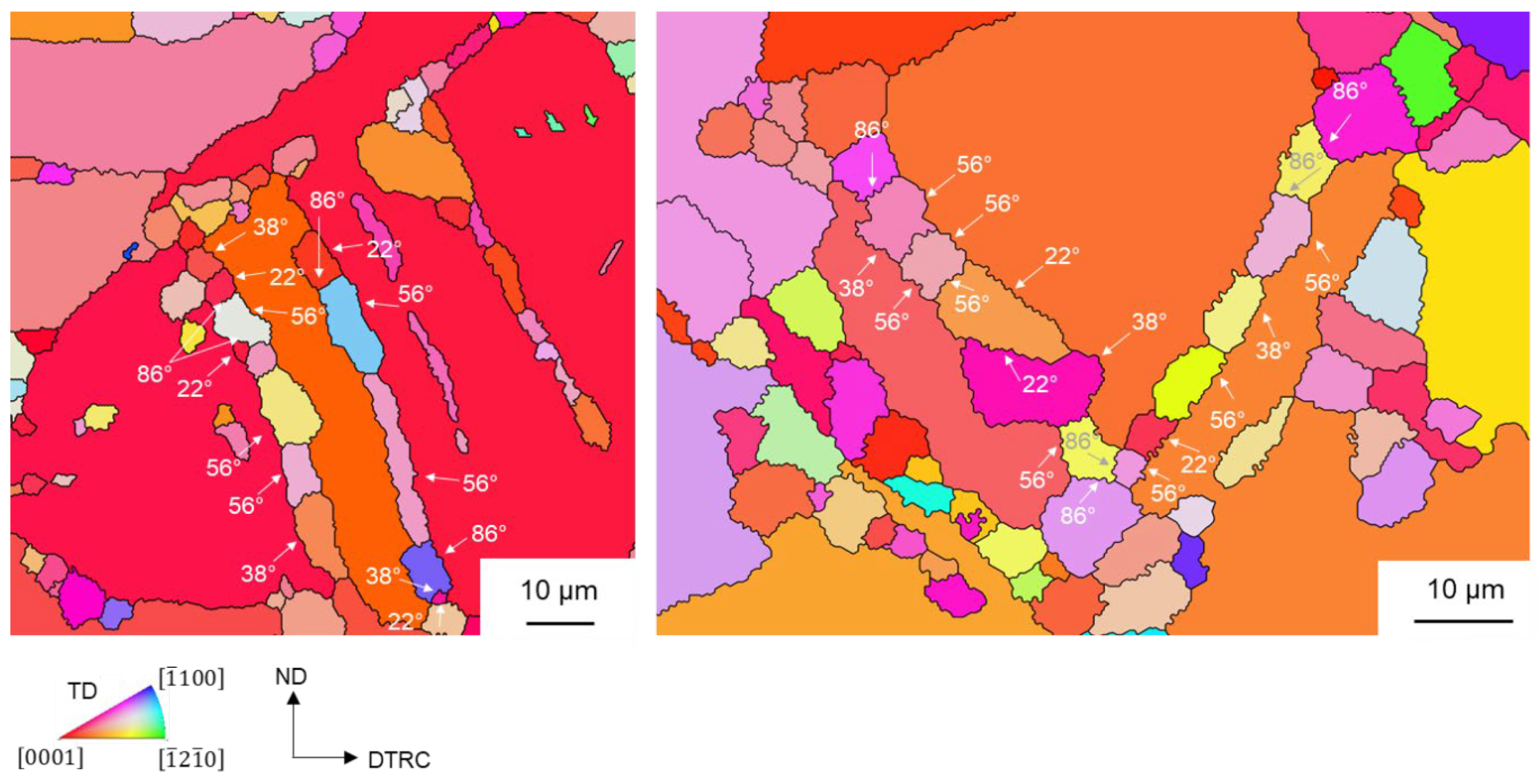
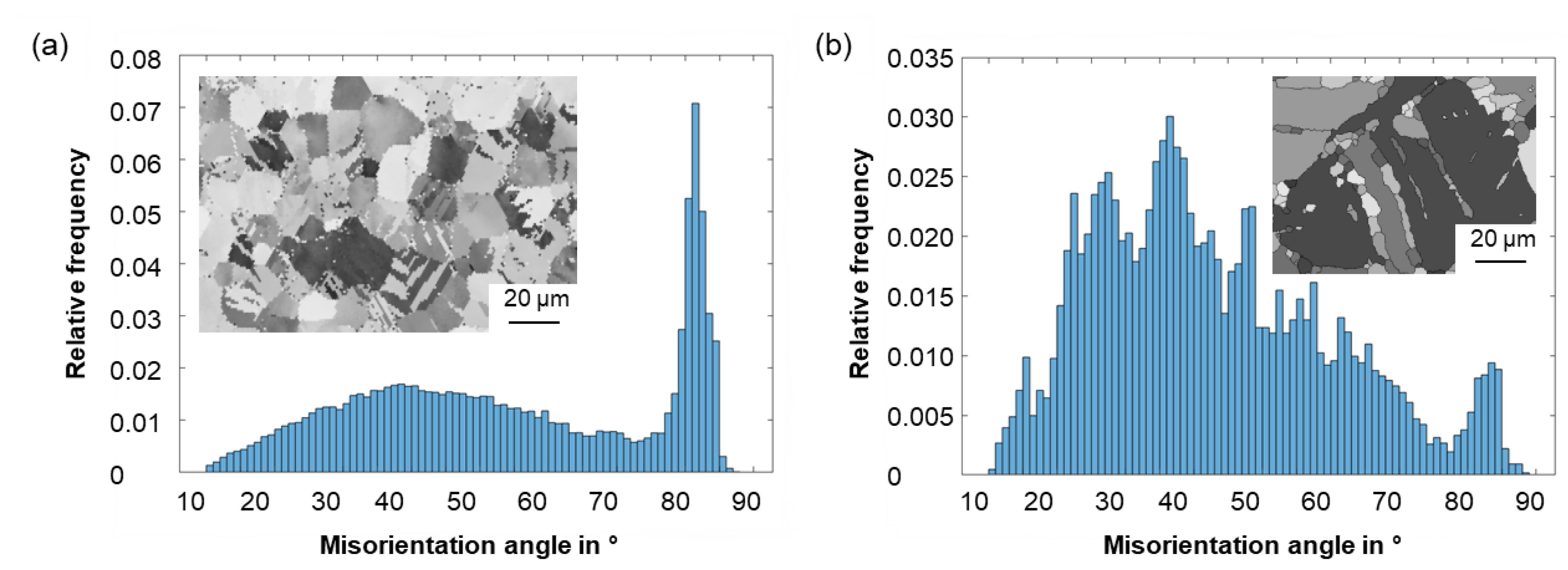
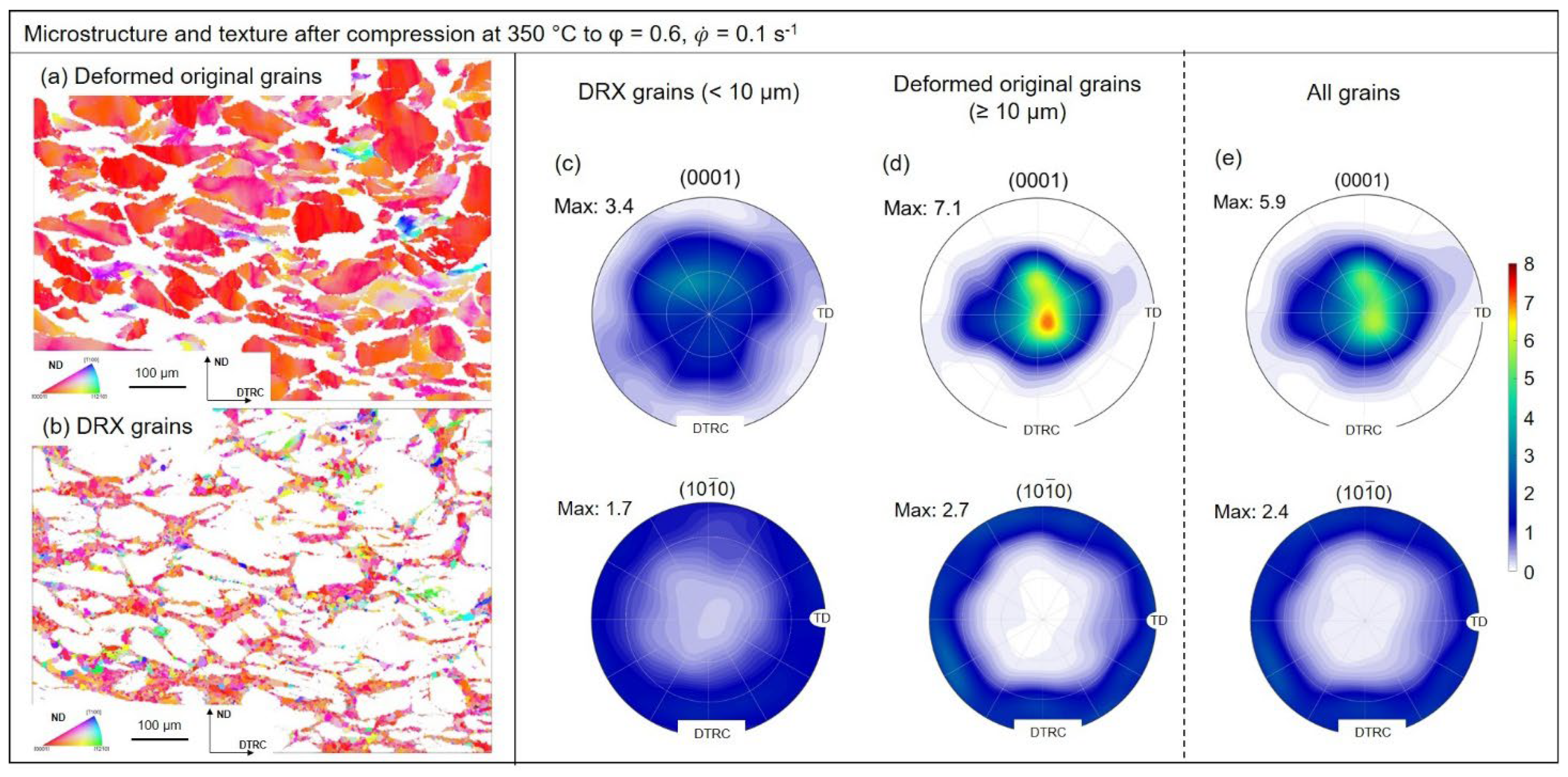
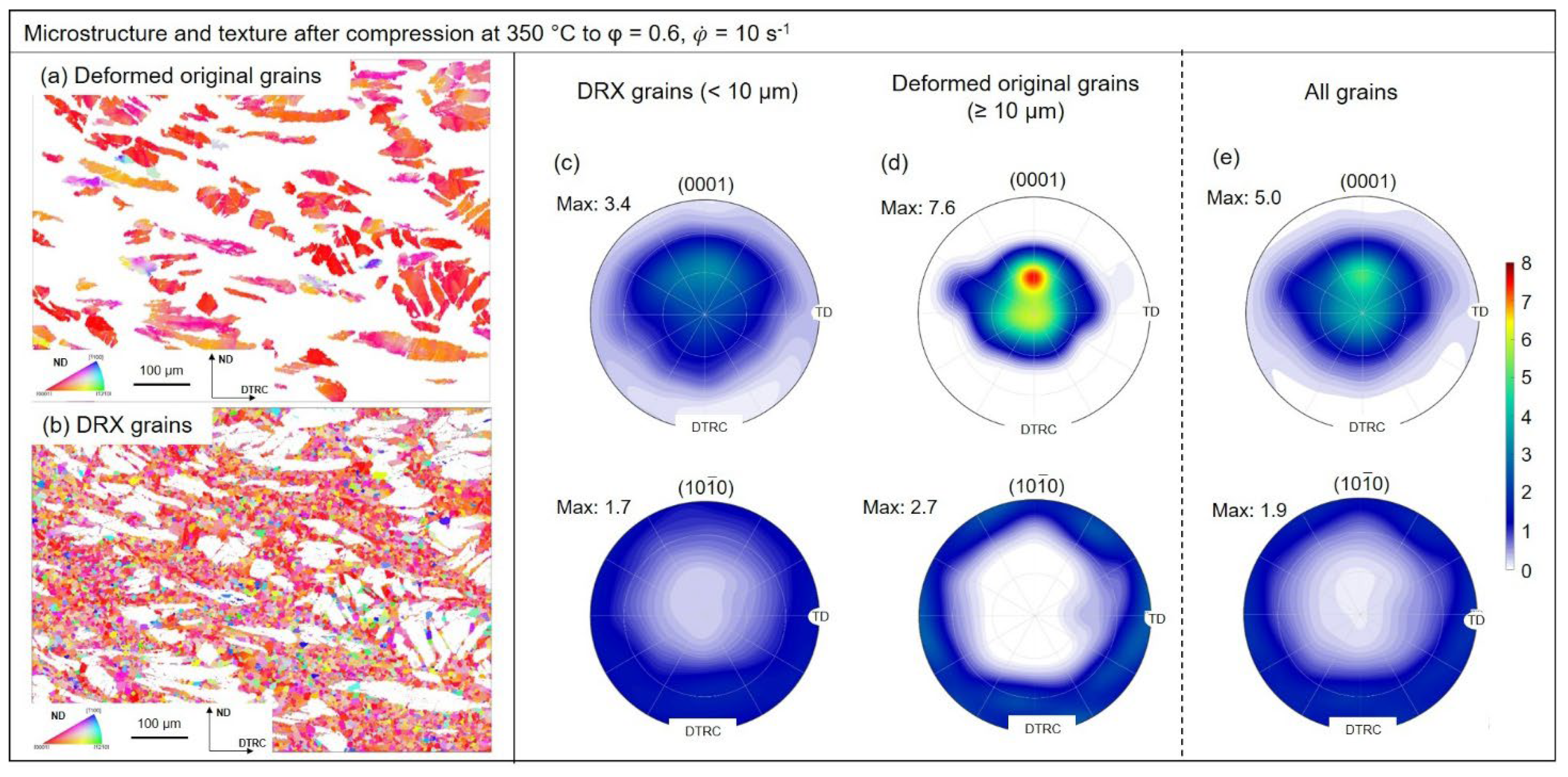
Publisher’s Note: MDPI stays neutral with regard to jurisdictional claims in published maps and institutional affiliations. |
© 2022 by the authors. Licensee MDPI, Basel, Switzerland. This article is an open access article distributed under the terms and conditions of the Creative Commons Attribution (CC BY) license (https://creativecommons.org/licenses/by/4.0/).
Share and Cite
Kittner, K.; Ullmann, M.; Prahl, U. Microstructural and Textural Investigation of an Mg-Zn-Al-Ca Alloy after Hot Plane Strain Compression. Materials 2022, 15, 7499. https://doi.org/10.3390/ma15217499
Kittner K, Ullmann M, Prahl U. Microstructural and Textural Investigation of an Mg-Zn-Al-Ca Alloy after Hot Plane Strain Compression. Materials. 2022; 15(21):7499. https://doi.org/10.3390/ma15217499
Chicago/Turabian StyleKittner, Kristina, Madlen Ullmann, and Ulrich Prahl. 2022. "Microstructural and Textural Investigation of an Mg-Zn-Al-Ca Alloy after Hot Plane Strain Compression" Materials 15, no. 21: 7499. https://doi.org/10.3390/ma15217499
APA StyleKittner, K., Ullmann, M., & Prahl, U. (2022). Microstructural and Textural Investigation of an Mg-Zn-Al-Ca Alloy after Hot Plane Strain Compression. Materials, 15(21), 7499. https://doi.org/10.3390/ma15217499








